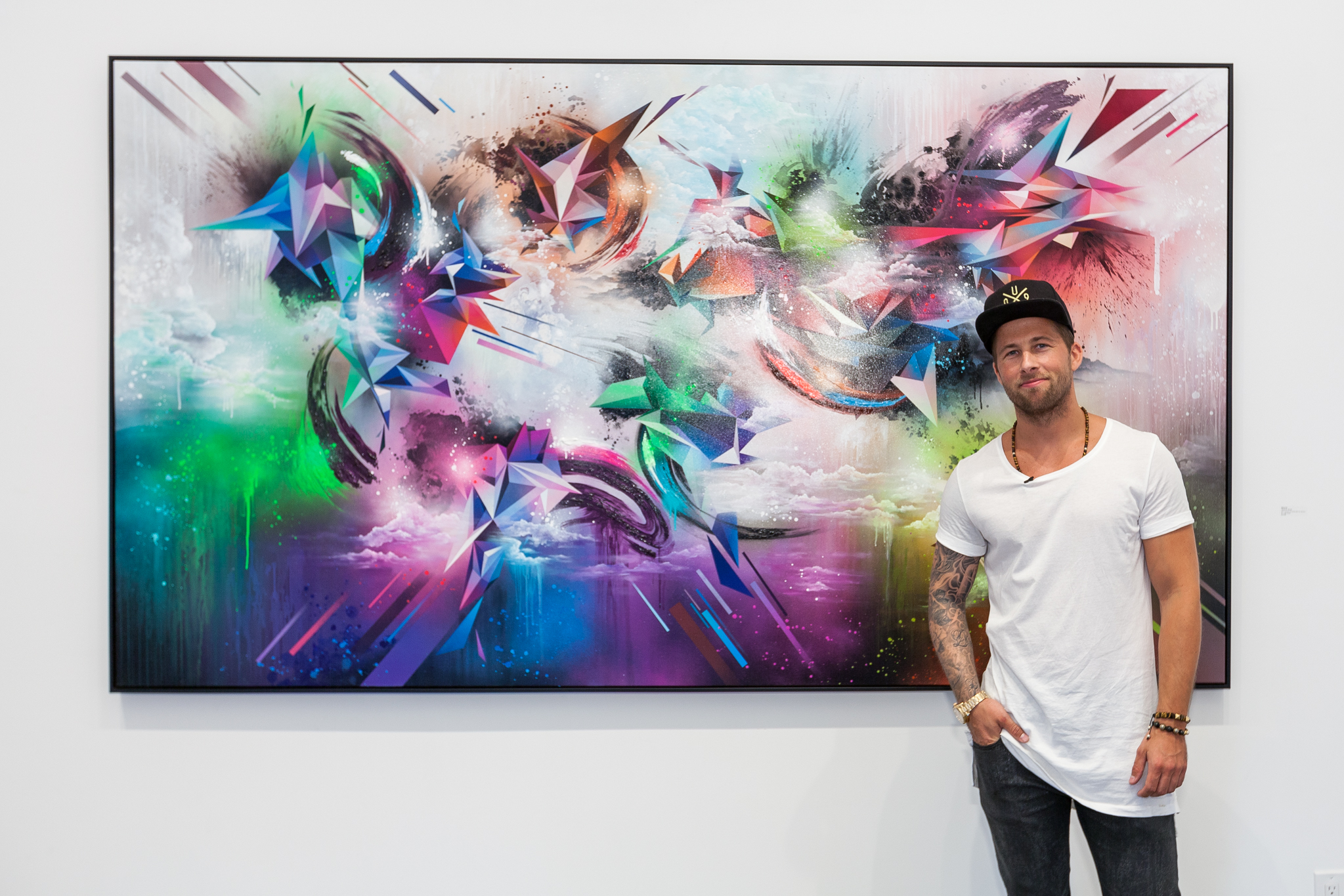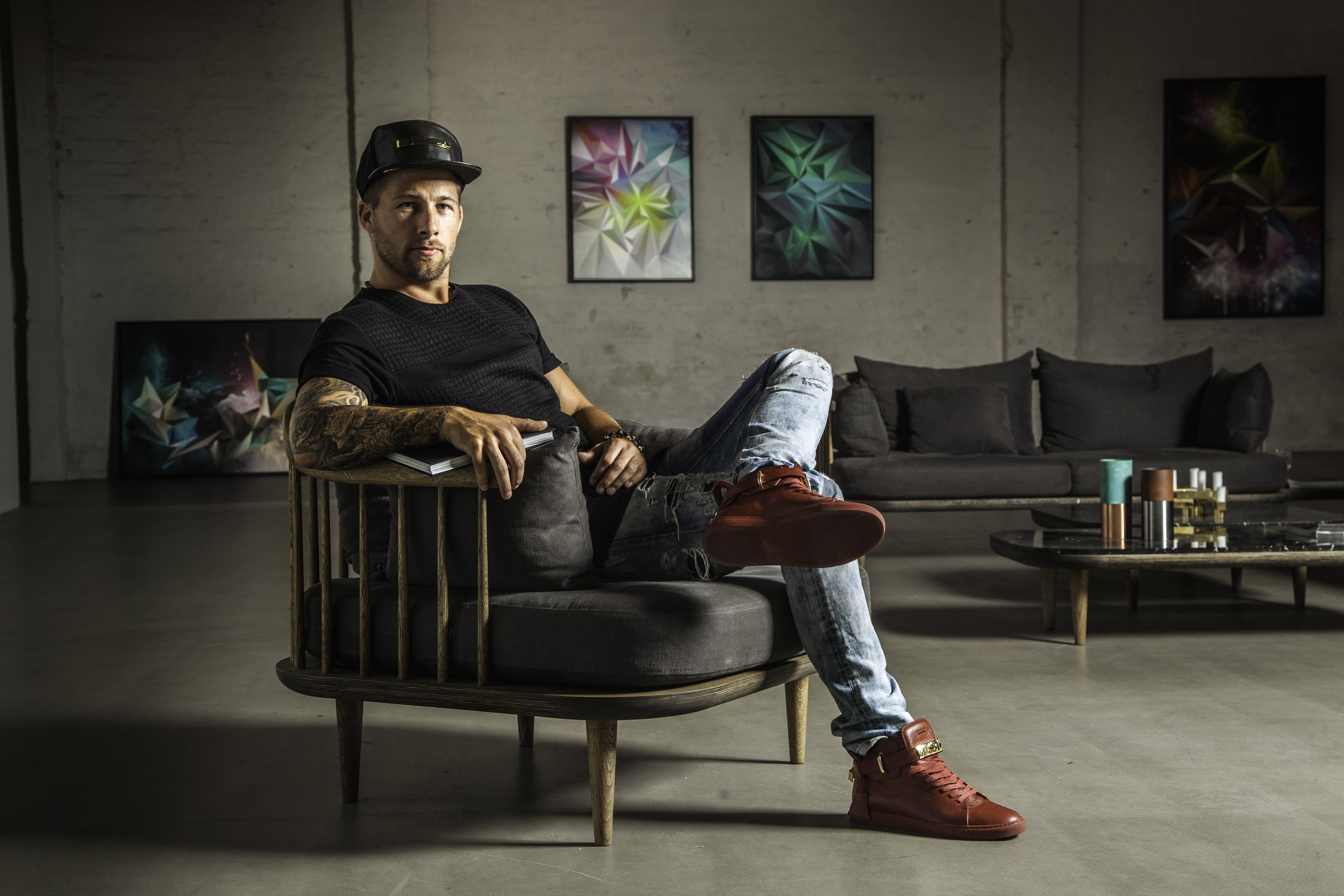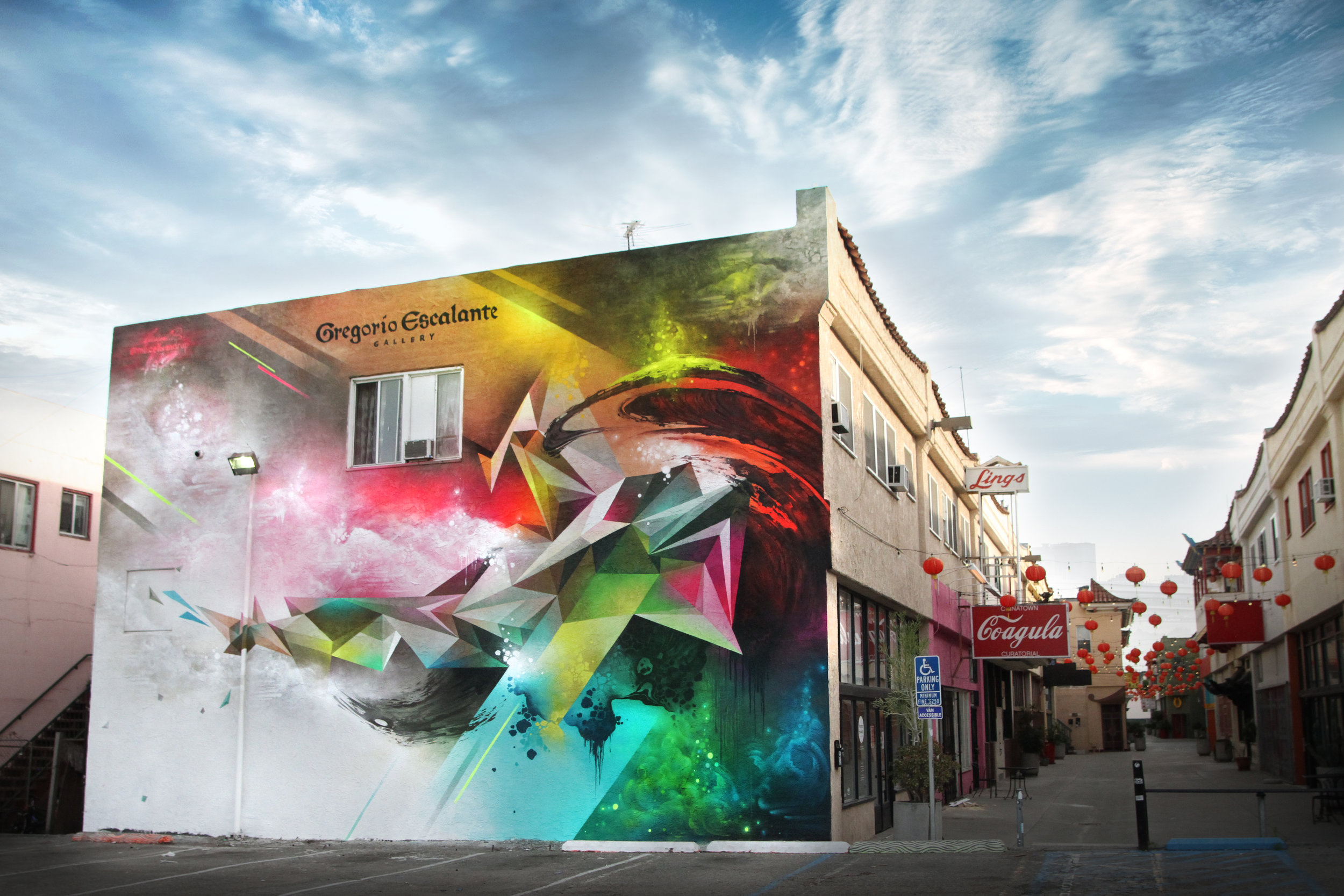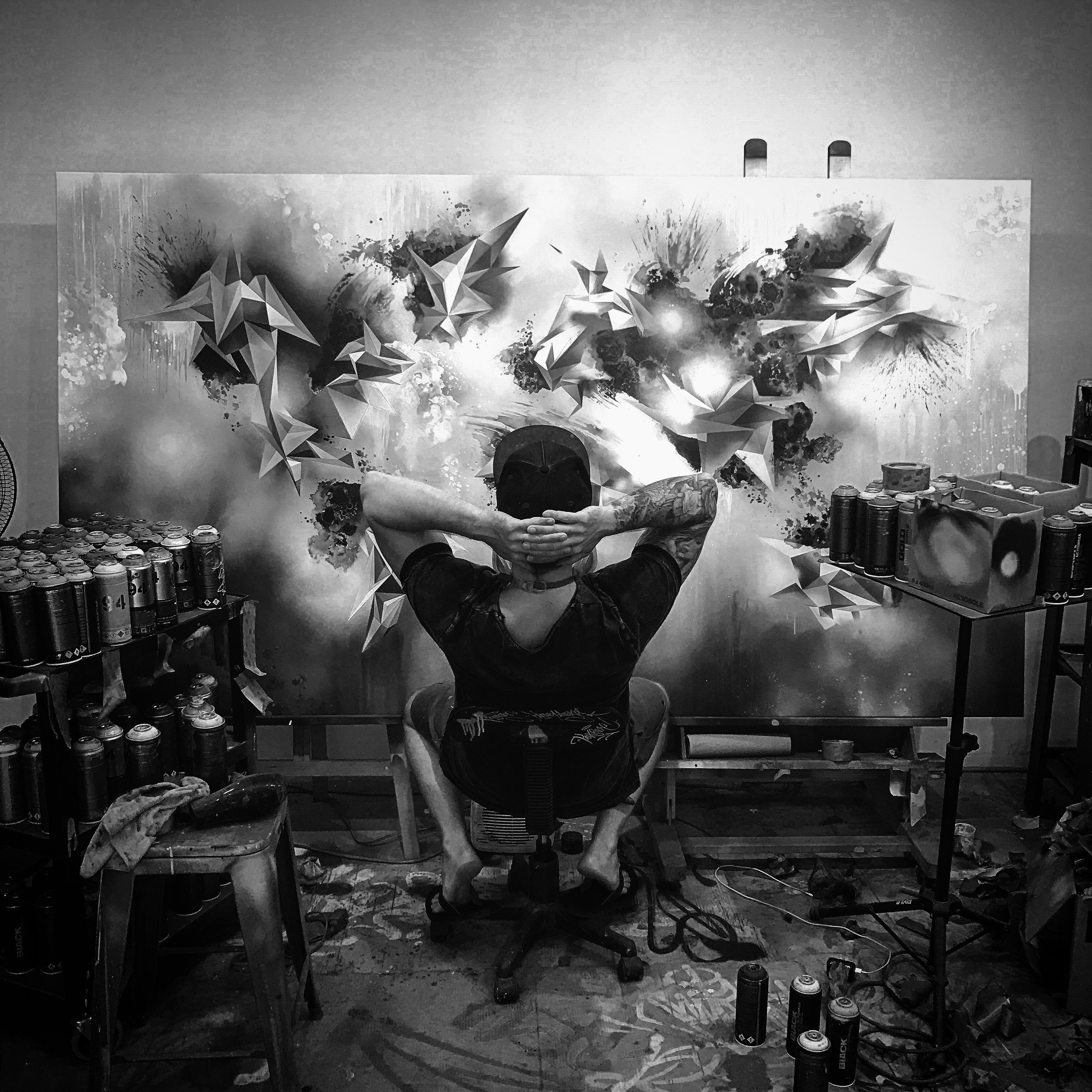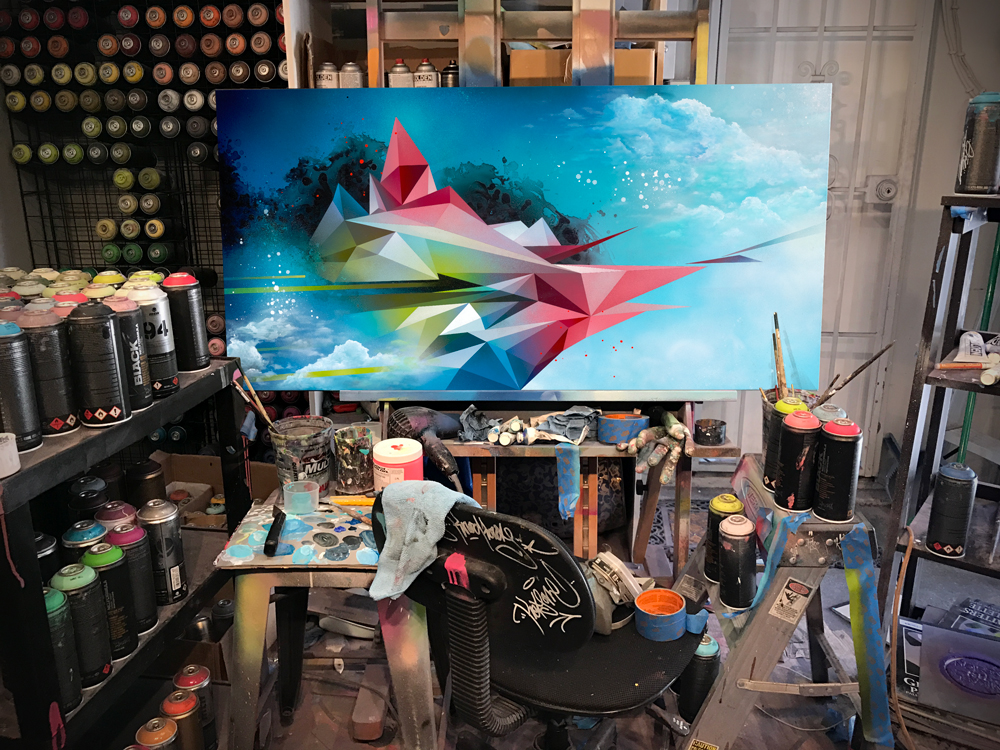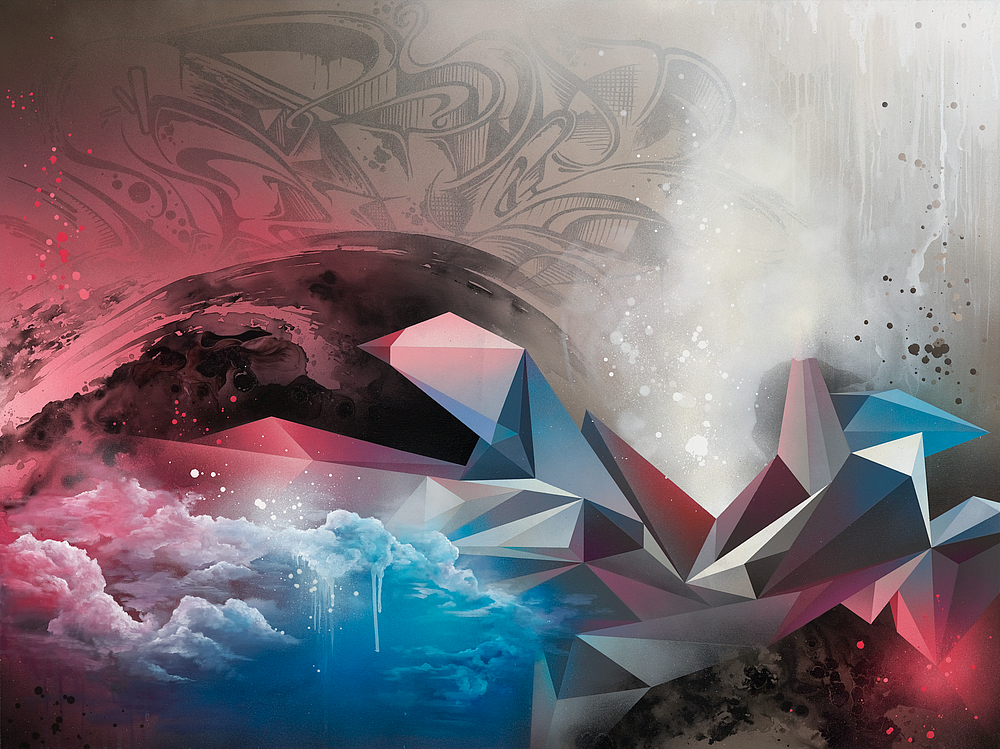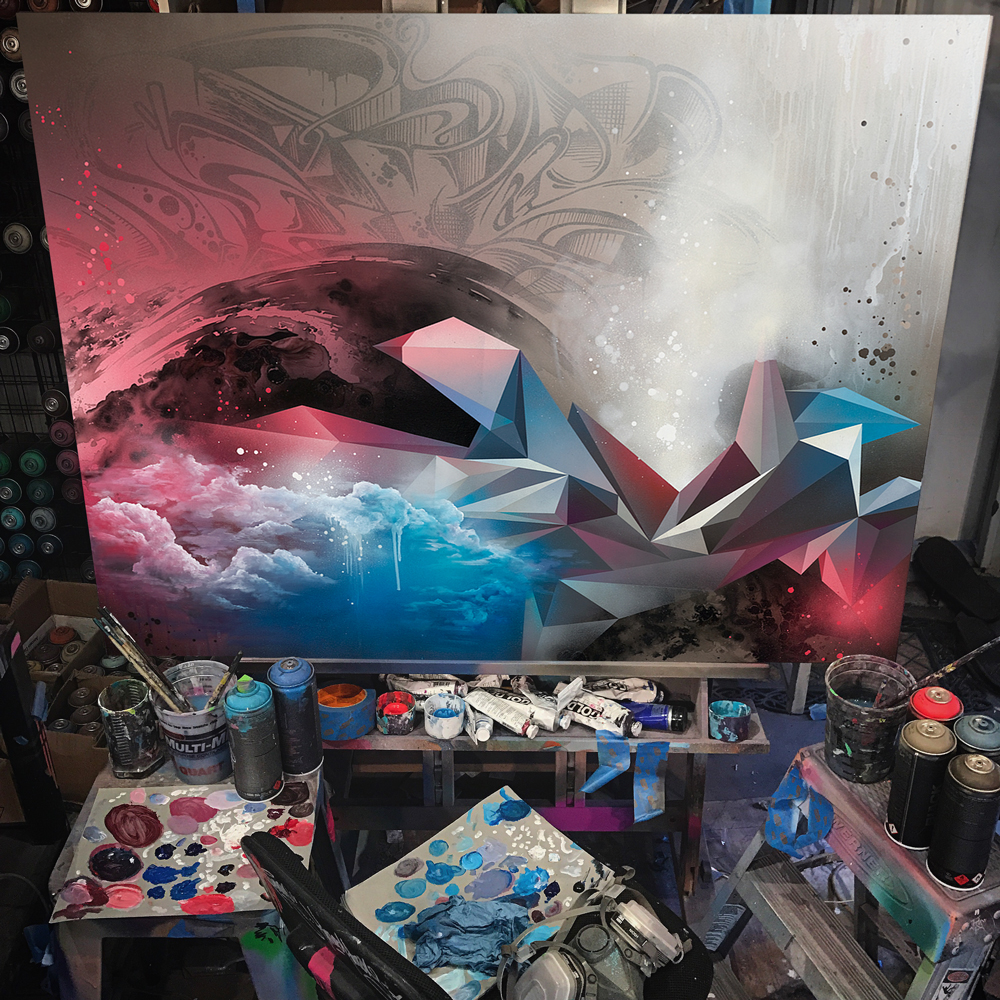Artist Profile: Mikael B
Walking through Reality Shift the newest endeavor from Danish born artist Mikael Brandrup, it’s easy to see his roots lie in graffiti and graphic design, having built a bona fide street empire in Denmark. The vivid, neon colors and bold, geometric shapes suggest a background of street art with a unique eye for creating alternate realities on the canvas. Indeed, Mikael’s earliest canvases were the walls of nearby businesses in his hometown of Tuse Næs, west of Copenhagen. Under the alias KETS, he painted hundreds of wall murals in only a few years, thus laying the groundwork for an audacious career in graphic design and visual arts. Now known as Mikael B, "Reality Shift" is the artist's first solo show after an immense sold-out exhibit in Copenhagen
From 2008 to 2013, Mikael B founded and operated the design agency IDentity Provided, followed by Mikael B Design in 2013. Since achieving one of his life-long goals of moving to Los Angeles in 2014, the largest companies in the world have taken note of his art and its explosive energy — his resumé is now overflowing with impressive artworks on canvas and walls, commissioned by clients that include Google, LinkedIn, Nike, American Express and features in dozens of prestigious publications like LA Times, along with a slew of television appearances in his Danish home country.
While wandering through the gallery, we asked the artist about a large canvas that caught our eye— the free flowing and dreamlike quality of this piece stood out next to its geometric counterparts. He agreed it was a departure from his usual style and had been a challenge for him, but something that he would like to explore further. Wherever his creativity takes him next, it’s clear Mikael will be making an impact on the art and design arena for years to come. In the same way that every Mikael B piece invites the observer into a limitless universe, what’s next for this artist is certainly boundless and immeasurable as well. Following his opening, Mikael spoke with Rogue about his creative process, what motivates him as an artist and the challenges he's faced along the road to success.
ROGUE: What drew you into the world of illustration and painting?
Mikael: I’ve been drawing since the moment I could hold a pen. It seemed very natural and satisfying to express myself drawing and painting so I became completely obsessed and passionate about it. I grew up seeing how the hip-hop culture and graffiti evolved around me. It inspired me to experiment with spray cans as well. I painted my first graffiti piece on some wood panels in my parents backyard when I was 15 years-old and have kept going ever since.
R: Let’s talk about your latest series “Reality Shift”. What was the impetus for this collection? Seems you’ve drawn from your background in graffiti and graphic design – can you tell us about what influences trickled into the art?
“Reality Shift” has been a huge revolution in my style. The new color schemes and visuals I’m exploring are a direct result of having moved to Los Angeles and gotten used to the way of life here—the way my dreams have become reality in a very short amount time. It’s a “reality shift” because for so long I’ve been inspired by the urban art scene of Southern California, and now I live here and get to be a part of it myself. My entire reality has changed in just a few short years.
R: How long did it take you to put together your show and what was the most challenging part of the process?
I’ve been working on this body of work for the past 12 months. I have so many ideas and thoughts in my head, so the challenge was to choose between all this going on in my head and making it a reality. I’m very structured and usually I have a detailed sketch and color scheme before I start, but with the piece “Hyperdrive” I forced myself to go to the blank canvas with nothing planned. That was amazing and it reminds me of the freestyle process I usually have with my graffiti walls – getting inspired by the moment. Doing my first sculpture/3D wall piece “Hypercube” was quite challenging and it took me forever to figure out how I wanted it, but challenges comes with satisfaction and I couldn’t be more happy how my first sculpture project turned out.
R: How long have you been making art & what 1st attracted you to it?
I’ve been making art for my entire life. I spent my childhood drawing and painting with acrylics, but was seeing more and more graffiti art all over Copenhagen and on the train into the city. I wanted to start creating more work like that. So when I was fifteen I picked up my first spray can and started experimenting on wooden boards in my parent’s backyard. And from that moment on I was hooked on that style.
R: We loved your mural outside the gallery. Tell us about your process when creating large scale artwork like your murals -where does it begin, where does it end?
I sketch a lot—the good old fashion way with pen and paper. That’s how I get my thoughts/ideas out of my head the best way. So this process is where I create the composition and how I’ll make my concept fit into the wall dimensions. I don’t think about colors until I’m close to 100% satisfied with the b/w sketch – it keeps my mind focusing on the shapes and overall flow. After, I do a color sketch and mural mockup on my computer. From this I make a complete list of the paint and colors I need and then I’m ready to hit the wall and start painting. From this point it took me 4 - 5 days to complete the 60' x 40' mural.
R: Does your background in graffiti and graphic design inform your artwork and in what ways?
Graffiti and graphic design… Those two worlds used to be separated when I created my art pieces, but they slowly melted together. The wild brush strokes, the swinging and bending you see in my art pieces originate from my wildstyle graffiti. My graffiti has always been very vibrant and colorful and experimenting with contrast colors and contrast shapes. The two worlds started melting more together when I was merging my graphic design elements into my graffiti – the sharp geometrical shapes with the brush strokes and cloud shapes.
R: Was it a natural progression going from graffiti to graphic design to painting or did you find the progression difficult?
My progression has actually been drawing, then graffiti, then graphic design, and the progression has always been very natural and organic with those skill sets slowly melting together. The reason I became a graphic designer is because I loved visual communication and branding, so I wanted to be able to help companies with their corporate visual identity. However I skipped my education after a couple of years to start my own design agency. Having my own design agency for over 5 years with clients such a Chiquita and Sten&Strøm was my education, learning by doing and getting shaped by the real world. Helping brands succeed in the marketplace made me realize that I could do the same with my own art.
R: How would you describe your style?
Wild-style graffiti is always at the basis of my work, but I use traditional painting techniques to create. My cloud shapes and experiment with chemical reactions and sculpture materials. It’s a hybrid of classic wildstyle graffiti and fine art painting. I would call it Urban Contemporary.
R: Has living in LA, versus your home country of Denmark, factored into how you approach and create art? How has your art changed since moving to the United States?
Yes, that’s actually the whole idea behind “Reality Shift.” I’m incorporating more and more of my different skills as a visual artist. For this show especially, the colors I use have really changed as a direct result of adjusting to living in Los Angeles, the ideas I wanted to convey were more about having dreams fulfilled than longing for a certain future.
R: What sort of artists inspire you?
Growing up in the 80’s and 90’s I saw so much inspiring lettering on the trains to Copenhagen and on the streets around the city. A lot of huge graffiti writers like Bates, Swet, Dare and CMP doing lettering all over the city, but also making characters and backgrounds and these amazing trackside sceneries. I fell in love with it all, and it inspired me to make the paintings and drawings I was doing with a spraycan.
R: You’ve collaborated with some incredible artists – what do you enjoy about the collaboration process that might be different from creating a solo show?
When you work with another artist it’s interesting not only because you can share your passion with a fellow artist and exchange techniques but also the result of combining two different styles and ways of thinking. Collaborations are a great way to grow as an artist!
R: It’s important not to get too comfortable as an artist—there has to be something at stake that keeps one from getting too comfortable, to keep one growing. What for you is at stake?
I’m an entrepreneur by nature, it feels natural to me to push myself to do better and work harder everyday. I have great people working with me, especially my twin brother pushing me to kick ass every day and the other way around. Following my heart and my passion 100% everyday make me take chances and experiment all the time – whatever takes. It motivates my whole team and that synergy that happens makes the magic happen.
R: What are some of the challenges you’ve experienced along the way, not just in making your art but in getting it released into the world?
Establishing an art brand and not just selling your pieces here and there is the challenge. Creating the brand and the name was and still is hard work. Coming to the USA with nobody knowing who you are and what you do was tough. It was starting all over again, networking, meeting gallerists, artists etc—getting your work out. I remember my first year in LA I went to art shows, exhibitions etc like five times a week to meet people and get an idea of the art business and gallery scene which is completely different from europe. And on the side comes all the practical stuff that comes with escaping the safe environment and education. Getting my artist visa so I could live and work in the US was quite a challenge as well.
R: What motivates you the most as an artist?
Being able to create and visualize what's going on in my mind and heart. To share that deep deep passion with collectors, fans, friends, family and see how much my creations mean to them and their everyday life.
R: What does success mean to you?
To wake up every morning and live off my deepest passion in life and to realize my dreams. To be able to share that passion and inspire people around me.
R: What advice would you give to someone aspiring to become a fine artist in this day & age?
I would love talk about this for hours, but I’ll try to keep it short and give you a few pieces of advice: To become a successful artist you'll need be as much an entrepreneur as you are an artist. Meaning, what you are doing as an artist is a business. Don’t do it if you’re not obsessed, don’t do it if you’re not passionate. When you love what you do it doesn’t feel like work, and it makes you work all the time. Surround yourself with people that believe in you and want to keep pushing with you.
Mikael B's exhibition is open for viewing July 15th-August 20th at Gregorio Escalante Gallery
Written by Katie McGehee
Photos by Mickie Poulsen




